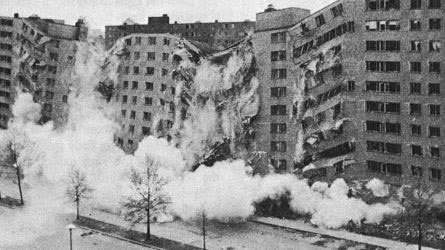I recently had an opportunity to view
the documentary The Pruitt-Igoe Myth,
which I touched upon earlier in this blog. In this film, many
residents of the infamous public housing development reflect upon the
time they lived there, the community that existed, and it's ultimate
undoing.
The residents
interviewed for the film, some who had lived in the development since
the beginning, others who moved in during its period of decline, all
noted that throughout the lifetime of Pruitt-Igoe, a strong community
developed, first based on the joy and pride that came from living in
such a new, modern place, and later as a counter to the decline of
the complex and its neglect by local, state, and federal housing
officials.
The documentary
notes that what caused the ultimate undoing of the development, a
post-industrial city with a declining population, miscalculations of
growth, and policy, both formal and informal that maintained the
racial segregation of St. Louis's housing stock, keeping African
Americans from entry-level jobs, had little to do with the modernist
movement, architectural features of the buildings (or lack thereof),
or the quality of the community created within them.
Jane
Jacobs, in her landmark Death and Life of Great American
Cities notes that housing
developments such as these will inherently fail due to their
architectural characteristics, such as massive scale, large open
spaces with little use, and lack of economic diversity or mixed uses.
However, from this documentary it is apparent that such a community
did develop, and that, for a time, it was able to benefit and look
after the residents of Pruitt Igoe.
Ultimately, the
downfall of this community, and the housing complex, was caused by
insufficient maintenance, a shrinking population, and a bureaucracy
that ultimately was apathetic to such problems as they affected many
similar public housing units around the country. In other words, the
massive resources that a public housing development of this scale
needed to succeed were not available.
In this sense, the
point Jacobs makes is that development or refurbishment is most
efficient and useful if it occurs in forms already recognized in the
neighborhood it is located in, as this development can be supported
by existing infrastructure, with existing means. In order to work
properly, modernist public housing on a large scale would require
massive amounts of continued funding, which would likely be
unsustainable.
Jacobs notes this,
and tells the reader that when the word “project” is used to
describe such a development, it conjures very specific things, namely
that the development, and those who live in it, are fundamentally
different than their surroundings. Death and Life of Great
American Cities describes in detail how cities can be revitalized
by using their intrinsic characteristics, a much less intrusive
practice than the modernist approach, and one that is ultimately more
sustainable.
In this way, the
film's claim that Pruitt Igoe should not be used as an example of
modernist failings is somewhat inaccurate. Pruitt Igoe demonstrated
that the modernist approach would work as long as large sums of money
were provided over the lifespan of modernist developments. The
political reality prevented (and continues to prevent) such sums of
money being spent on public housing, necessitating a more efficient
approach.
It can be argued that Jacobs approach to housing is more practical because it uses the intrinsic features of an urban environment to promote social and economic growth. This prevents unnecessary sums of money being spent on imposing “order” on an “chaotic mess”to use descriptions common amongst modern architects and correcting what is actually a non-problem.
This is the core
reason that large scale public housing complexes such as Pruitt-Igoe
should not be repeated, they are the hallmark of construction for
construction's sake, and only work if continuously supplied with
funding.




No comments:
Post a Comment